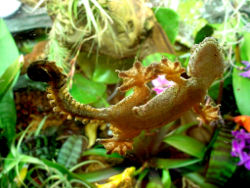- Ptychozoon kuhli
-
Ptychozoon kuhli
Ptychozoon kuhli

Classification classique Règne Animalia Embranchement Chordata Sous-embr. Vertebrata Classe Reptilia Ordre Squamata Infra-ordre Gekkota Famille Gekkonidae Sous-famille Gekkoninae Genre Ptychozoon Nom binominal Ptychozoon kuhli
Stejneger, 1902Caractéristiques Répartition Asie (sud) Climat humide Hygrométrie ~ 80 % T° diurne 
~ 25 °C T° nocturne 
~ 20 °C Taille (max) 20 cm Période nocturne Nourriture insectivore Mode de vie arboricole  Retrouvez ce taxon sur Wikispecies
Retrouvez ce taxon sur Wikispecies
D'autres documents multimédia
sont disponibles sur CommonsParcourez la biologie sur Wikipédia : Ces geckos sont appelés geckos volants, car ils ont la particularité de s'élancer dans le vide pour planer vers un autre arbre ou le sol, en particulier en cas de danger. Ils peuvent réaliser ces sauts grâce à de petites membranes de peau entre les pattes antérieures et postérieures, leurs pattes palmées et leur queue aplatie et bordée de peau.
Sommaire
Répartition géographique
On trouve cette espèce dans le sud de l'Asie, comme en Thaïlande, en Inde, en Malaisie, en Indonésie et à Singapour.
Sous-espèces
Aucune sous-espèce connue à ce jour.
Paramètres climatiques
Élevage en captivité
Il s'agit bien sûr d'un terrarium de type tropical humide. Afin de garder une humidité supérieure à 80%, il faut prévoir de l'eau au sol, renouvelée régulièrement. De plus, des pulvérisations d'eau sur les parois peuvent aider. La présence de plantes aide également à maintenir une humidité importante. Prévoir également un terrarium de type arboricole (vertical) relativement grand car ces geckos se déplacent beaucoup.
Alimentation
Insectivores, ils consomment la plupart des insectes de taille adaptée.
Comportement
Il semble que les mâles ne soient pas très territoriaux. Il est donc possible d'avoir plusieurs mâles dans le même terrarium, à condition que le nombre de femelles soit en conséquence et qu'il y ait suffisamment d'espace pour que chacun puisse avoir son espace vital.
Maturité
Les petits sont matures vers un an.
Sexage
Les mâles présentent deux renflements à la base de la queue, logement des hémipénis.
Reproduction
La reproduction se fait vers les 13 à 15 mois à condition de bénéficier d'une bonne alimentation sous peine de carences
Pontes
La femelle ptychozoon pond en générale 2 oeufs maximum de 4 à 6 semaines après l'accouplement fécond
Incubation
Les œufs doivent être incubés à une température de 25-30°C, avec une humidité de 80%.
Les petits
Attention aux jeunes, les mâles ayant tendance à les dévorer (les élever dans un terrarium séparé jusqu'à ce qu'ils aient atteint une taille correcte).
Maladies
Philatélie
Cette espèce a été représentée sur un timbre du Cambodge en 1993 (sous le nom Ptychozoon homalocephalum) et sur un timbre de Mongolie en 1991.
Voir aussi
Photos :
Feuilles de soin :
- Gekkota.com (anglais)
Références :
- Wood, Perry L.; Hinrich Kaiser; Stephany Looper; Timothy M. Youmans; Jesse L. Grismer and L. Lee Grismer 2004 A first report on the herpetofauna of Pulau Besar, Johor, West Malaysia. Hamadryad 28 (1&2): 106-109
- Tweedie, M.W.F. 1954 Notes on Malayan reptiles, No.3. Bull. Raffl. Mus. No 25: 107-117
- Taylor, E.H. 1963 The lizards of Thailand. Kans. Univ. Sci. Bull., Lawrence, 44: 687-1077.
- Stejneger,L. 1902 Ptychozoon kuhli, a new name for P. homalocephalum. Proc. Biol. Soc. (Washington) 15: 37
- Mertens, Robert;Senfft, Walter 1929 Aus dem Leben des Faltengeckos (Ptychozoon kuhli Stejneger) Natur und Museum 59 (4): 218-224
- Lönnberg, E. 1899 On a small collection of Javanese reptiles containing a new species of snake. Zool. Anz. 22: 108-111
- Kopstein, F. 1938 Ein Beitrag zur Eierkunde und zur Fortpflanzung der Malaiischen Reptilien. Bull. Raffl. Mus. No 14: 81-167
- Günther, A. 1864 The Reptiles of British India. London (Taylor & Francis), xxvii + 452 pp.
- Grismer, L.L., McGuire, J.A.; Sosa, R. & Kaiser, H. 2002 Revised checklist and comments on the terrestrial herpetofauna of Pulau Tioman, Peninsular Malaysia. Herp. Rev. 33 (1): 26-29
- Duméril, A.M. C. and G. Bibron. 1836 Erpetologie Générale ou Histoire Naturelle Complete des Reptiles. Vol.3. Libr. Encyclopédique Roret, Paris, 528 pp.
- de Rooij, N. de 1915 The Reptiles of the Indo-Australian Archipelago. I. Lacertilia, Chelonia, Emydosauria. Leiden (E. J. Brill), xiv + 384 pp.
- Creveldt 1809 Beschreibung einer neuen Eidechse aus der Gattung der Geckonen. Gesellschaft Naturforschender Freunde zu Berlin, Magazin für die Neuesten Entdeckungen in der Gesammten Naturkunde, Berlin 3: 266-274
- Cox, Merel J.; Van Dijk, Peter Paul; Jarujin Nabhitabhata & Thirakhupt,Kumthorn 1998 A Photographic Guide to Snakes and Other Reptiles of Peninsular Malaysia, Singapore and Thailand. Ralph Curtis Publishing, 144 pp.
- Chan-ard,T.; Grossmann,W.; Gumprecht,A. & Schulz,K. D. 1999 Amphibians and reptiles of peninsular Malaysia and Thailand - an illustrated checklist [bilingual English and German]. Bushmaster Publications, Würselen, Gemany, 240 pp.
- Brown, Rafe M. 1999 New species of parachute gecko (Squamata: Gekkonidae: genus Ptychozoon) from northeastern Thailand and central Vietnam. Copeia 1999 (4): 990-1001
- Brown, Rafe M., John W. Ferner and Arvin C. Diesmos. 1997 Definition of the Philippine Parachute Gecko, Ptychozoon intermedium Taylor 1915 (Reptilia: Squamata: gekkonidae): Redescription, designation of a neotype, and comparisons with related species. Herpetologica 53 (3):357-373.
- Boulenger, George A. 1890 The Fauna of British India, Including Ceylon and Burma. Reptilia and Batrachia. Taylor & Francis, London, xviii, 541 pp.
- Boulenger, G.A. 1885 Catalogue of the Lizards in the British Museum (Nat. Hist.) I. Geckonidae, Eublepharidae, Uroplatidae, Pygopodidae, Agamidae. London: 450 pp.
- Atlas de la terrariophile Vol.3 : les lézards. Animalia Éditions, 2003. ISBN 2-9517895-2-1
Liens externes
- Référence Animal Diversity Web : Ptychozoon kuhli (en)
- Référence Gekkota : Feuille de soin de Ptychozoon kuhli (en)
- Référence Catalogue of Life : Ptychozoon kuhli STEJNEGER 1902 (en)
- Référence Gekkota : Photographies de Ptychozoon kuhli (en)
- Portail de la zoologie
Catégories : Squamate (nom scientifique) | Geckonidé
Wikimedia Foundation. 2010.

